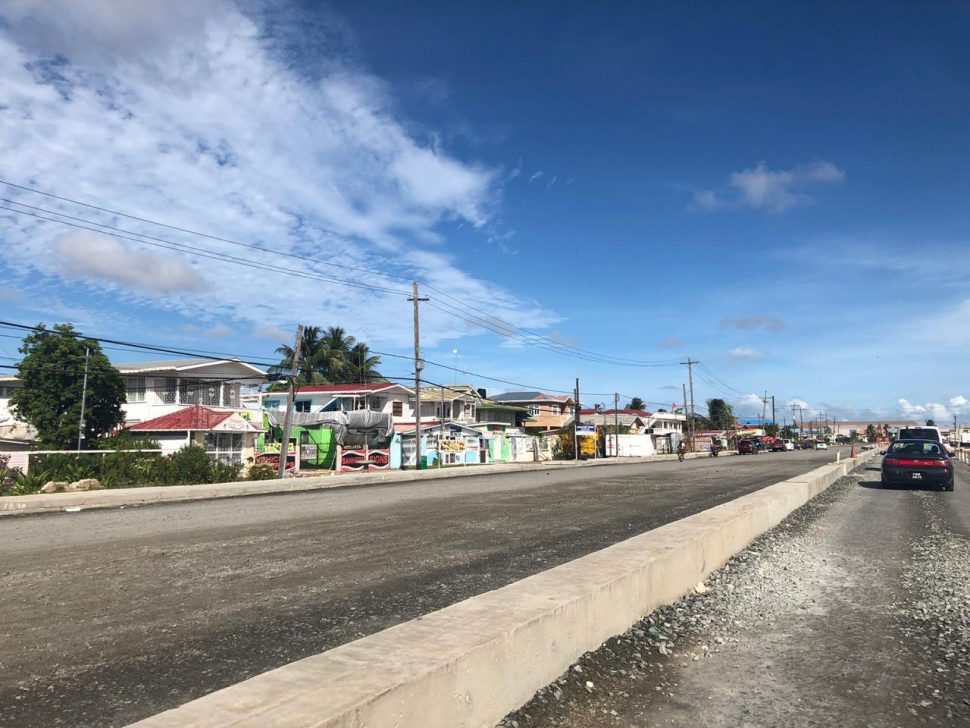A major contributing factor to the recent congestion on the East Coast Highway where a road upgrade and widening project is being carried out is drivers’ indiscipline, Ministry of Public Infrastructure Technical Services Managers for roads, Nigel Erskine says.
Roads users have complained about the slow pace of traffic due to the ongoing works. Despite numerous interventions and changes aimed at assisting with the smooth flow of traffic, Erskine says that indiscipline by drivers is one of the major factors.
“What is happening is that the congestion is happening during the peak period [and] in a lot of the cases what is contributing to the congestion is indiscipline. You would have only one lane to go through the intersection at the bridges but what you would have is that like three lanes of traffic are converging at that point and only one can go through so that results in everyone being at a standstill,” he explained.
Erskine was speaking to Stabroek News yesterday on measures that have been put in place to significantly reduce the congestion that drivers are caught in during the peak period.
“We have a traffic management plan for the project. So when the design was done the traffic management plan would’ve been prepared which would’ve outlined some of the possible impacts the construction would’ve had on the traffic and it had some recommendations in terms of some measures that could be implemented”, Erskine said.
He noted that one of the measures was for there to be an adequate amount of signage along the construction zone including for the speed limit, warning signs indicating men are at work, diversion signs, pedestrian crossing signs and others.
“For the construction phase, there’s a total of about 250 warning signs and for the section from Better Hope to Annandale there’s about 180 signs. Since we would’ve done an audit like a month ago we decided to add an additional 40 signs so that has already been put in, and in terms of the signage I would want to urge persons for them to drive within the speed limit of 20 km/h,” Erskine said.
He also noted that the audit would’ve found that the offloading of materials during peak time would have also been a contributing factor to the slow traffic. To remedy this, they would have instructed the contractor to stop offloading material during the peak period.
Flagmen
With reference to the flagmen who would often direct the traffic, Erskine said that they found that the men were not “using their initiative” and were not properly trained to handle the amount of traffic.
“When the trucks dump their loads, instead of encouraging the drivers to come they would walk off. So some training was done for these flagmen and they also took on some more, quite a few more. Initially that was one of the areas they were lacking in and I think about 20 more would’ve come on,” he said.
Erskine also explained that the water tenders that would often wet the road in order to prevent dust pollution were also affecting the traffic flow negatively, and they have since moved from letting the tenders wet the road during the peak period to a new system of doing it before and after the peak periods.
He also stated that they would’ve noticed that they were lacking in terms of regular public advisories and would’ve engaged GTT to have warnings sent through mobile phones. He also noted that they would’ve also been publishing more public advisories so drivers and other road users would be adequately informed about new developments that would hinder their journey.
“Also, in terms of diversions, we have engaged the police so you’ll notice they are working with us in terms of trying to regulate the flow of traffic. Those are some of the things we have put in place and we also have a hotline that persons can call and make complaints so we can log it and it would be recorded and the consultant would investigate it and then pass it on to the contractor,” Erskine added, while stating that there’s a final substantial completion certificate that the contractor would receive at the end of the project, but only if he has rectified all the issues that were brought to their attention.
Paving
He also added that the paving of the road, which will commence soon, will assist in minimising the congestion when completed.
“The preparatory works are going well and we started preparing the southern carriageway from Better Hope to Montrose, about 2 km or so. So, the preparatory works are almost finished and we are anticipating that by Wednesday the actual asphalt paving is going to begin and the primer has already been placed. Currently that lane is already closed off so we would’ve issued an advisory already about a week ago which states that the southern lane was closed off,” he said.
Erskine noted that the paving would take about four days and by the following Monday the section would be completed and then the northern side will be prepared and paved coming from Montrose to Better Hope. Within two weeks the 2 km stretch of road should be completed which, he said, will positively impact the congestion.
“I feel once the paving works start you will see a lot of ease in the terms of the build-up of traffic because you can go at higher speeds. Currently, overall, it’s at 40% completely but works are only going on the four-lane section which is about 70% completed. We’re working towards substantial completion by the end of the year and I mean that most of the paving works for the four-lane section should be at 90% and just minor works will be left,” he added.
Work on the project began last year August and is expected to be completed by August 2019. The project will see the widening of the carriageway from a two-lane road into four lanes between Better Hope and Annandale. After Annandale there will be an asphaltic concrete surface upgrade up to Belfield.
The project will result in 26 structures being widened to enable the four-lane road and two bridges will also be built to facilitate the road’s expansion. Additionally, 11 traffic light signals will be installed at various intersections, along with street lights, road safety signs and other speed reduction devices.
The contract was awarded to China Railway First Group Company Limited to the tune of US$46,995,941.34, with funding from the Government of Guyana and the Export-Import Bank of China. (Dhanash Ramroop)






